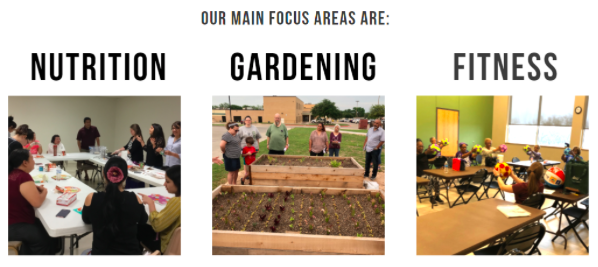by: Debbie Wright
As we gear up to celebrate St. Patrick’s Day, a holiday synonymous with the color green, let’s take a moment to reflect on how we can make our celebrations more eco-friendly and contribute positively to our community. This year, why not go beyond wearing green attire and consider participating in events that promote environmental consciousness and sustainability?
Community Composter Certification Course

March 14, 2024, marks the commencement of the Community Composter Certification Course, a remarkable initiative led by Emily Hills, the director of Urban REAP. This comprehensive program aims to educate residents of McLennan County about composting, fostering a network of compost educators and advocates within the community. Participants will delve into topics such as soil and decomposition, composting science, and community outreach, culminating in the creation of independent projects aimed at spreading awareness about composting. By participating in this course, individuals can not only enhance their understanding of sustainable practices but also actively contribute to reducing organic waste in our community.

Just a few days after St. Patrick’s Day, on March 22, we celebrate World Water Day. This year, let’s engage as a community to address water-related issues and promote conservation efforts. Take part in the Brazos River Cleanup and help keep our waterways pristine from 10am – 1pm. After the cleanup, head over to Indian Springs Park for a range of educational and interactive activities. Our partners, including Keep Waco Beautiful, City of Waco Watershed Protection, and more, will offer fun for all ages. Enjoy yard games, kids’ activities, free giveaways, and delicious food and drinks!
Backyard Composting Workshop – March 16
Looking for practical ways to reduce waste and enrich your garden soil? Attend the Backyard Composting Workshop on March 16th and learn how to start your own composting system. Gain valuable insights into the composting process and see firsthand how you can turn kitchen scraps and yard waste into nutrient-rich compost for your garden.
Spring Plant Share & Garden Day – March 16

Get into the spirit of spring by joining your neighbors at the Spring Plant Share & Garden Day. Share and adopt new plants, gather seeds, and participate in activities to prepare the Butterfly Sanctuary Garden for the season ahead. Learn from Master Gardeners, contribute to volunteer activities, and support the local ecosystem by donating plants for butterflies, pollinators, and birds.
Household Hazardous Waste Day – March 23

After the celebrations wind down, take the opportunity to declutter responsibly by participating in the Household Hazardous Waste Collection Day on March 23. Safely dispose of potentially hazardous items, ensuring they don’t harm the environment or endanger our community.
Companion Planting Workshop – March 30

Wrap up the month of March by attending the Companion Planting Workshop on March 30th. Discover the benefits of planting companions that help each other thrive in your garden space. Learn valuable tips from garden guru April Strickland and maximize the productivity of your garden while promoting biodiversity.
This St. Patrick’s Day, let’s go green in more ways than one. By engaging in these events and adopting sustainable practices, we can make a meaningful difference for our community and the planet. Join the movement towards a greener, more environmentally conscious future. Happy St. Patrick’s Day!
By Lindsey Breunig-Rodriguez
It has been several months since I last wrote an article for Act Locally Waco. I am happy to be back and ready to continue featuring different fruits and vegetables each month.

Bell peppers might be one of my favorite vegetables (be warned I will say this for four or five other veggies) due to their versatility, bright colors, and packed flavors. If you enjoy gardening, bell peppers are at the start of their season, (summer and fall) so be on the lookout for great deals at the grocery store or farmers market because buying vegetables in-season results in a fresher, tastier, and a lowest cost product.
Nutrition:
Per USDA dietary guidelines it is recommended we consume 3 cups of vegetables daily. Vegetables may be fresh, canned, frozen, or dried, and may be whole, cut-up, or pureed; it all counts. For bell peppers (all colors), a 1 cup serving is equal to 1 cup of chopped, raw, or cooked pepper or 1 large pepper (3″ diameter, 3¾” long). One small pepper is equal to ½ cup.
Bell peppers are a great source of Vitamin C, which keeps our immune system strong and helps our bodies heal quickly. Red bell peppers are higher in both Vitamin C and A compared to green bell peppers. Additionally, bell peppers are fat free, saturated-fat free, sodium free, cholesterol free, and low in calories.
Shopping, Storage, and Preparation:
In the summer we might see deals on fresh bell peppers, but we can also enjoy them in other forms like frozen and canned for good nutrition and convenience. If selecting fresh, choose firm, brightly colored peppers with tight skin that are heavy for their size. Avoid dull, shriveled, or bumpy peppers. Store fresh in the refrigerator for up to five days.
The skin of a bell pepper is fairly soft so little pressure is needed when cutting. This may be a great veggie to cut with children who want to work on knife skills; however, the shape can be intimidating. University of Maryland’s Extension program created a quick video on how to buy, store, and prepare bell peppers, watch here.
Enjoy:
Bell peppers are a staple in a variety of ethnic cuisines, including Asian (Chinese, Japanese, Korean), African, Latino, and Mediterranean. Enjoy bell peppers in a variety of different ways:

- Raw: A tasty addition for a veggie tray and are delicious with many kinds of dip or for extra crunch add to sandwiches and wraps.
- Grilled/Roasted/Sauteed: Indoor or outdoor, peppers will taste great with simply some oil and salt or other seasoning. A great addition to pasta sauce, a pizza topping, breakfast eggs, soups, or chili.
- Stuffed: Stuff with whatever you have available at home. A mixture of beans/meat, brown rice/grains, veggies, and spices can go such a long way and has endless combinations. Stuff the pepper and bake!
- Added to salads and casseroles.
Check out these other tasty recipes too: Simple Stuffed Peppers (a household favorite!), BBQ Chicken Pizza, and Mac and Beans Medley.
I hope you enjoy!
USDA is an equal opportunity provider and employer. This material was funded by USDA’s Supplemental Nutrition Assistance Program — SNAP. To learn more about the Supplemental Nutrition Assistance Program (SNAP) or to apply for benefits, visit www.yourtexasbenefits.com.

Lindsey Breunig-Rodriguez is an Extension Agent for the Better Living for Texans program with the Texas A&M AgriLife Extension Service. She is originally from Grapevine but now calls Waco home. A graduate from Baylor University, she loves to venture out to Cameron Park, visit the local Farmers Market, and try out the awesome eateries in Waco. If you see her and hear a loud bark, that’s her pup Lucy Ann just saying hello.
The Act Locally Waco blog publishes posts with a connection to these aspirations for Waco. If you are interested in writing for the Act Locally Waco Blog, please email Ferrell Foster at [email protected].
Editor: This is the second post to mark National Nutrition Month with the help of Lindsey Breunig-Rodriguez, McLennan County Extension agent.
By Paula Solano
Hello, March! In just a few short months we have experienced what seems like ALL of the seasons. The image selected seemed fitting given the lemons we seem to have been given in 2021. In February, I observed our community coming together in a time of need. Neighbors helping neighbors, warming centers and water filling stations. Freezing temperatures brought people together — a moment in time we will not soon forget.

During my time as an intern at the Texas A&M AgriLife Extension, I have gained increased understanding related to nutrition and physical activity. One of the highlights of my time is learning best practices from the knowledgeable staff. I’ve learned that living with a chronic disease is about lifestyle changes and awareness.
The seasonal fruit for this week’s Better Living for Texans blog is the lemon. While lemons are in season year-round, they are most flavorful and available in abundance during the winter. Lemons cultivate best in warm environments, such as California and Florida.
Lemons have a presence in various ethnic cuisines, including Asian / Southeast Asian (Cambodia, Laos, Vietnam) / African Cuban, Latino / Mediterranean / Mexican / Puerto Rican.
Nutritional Facts and Health Claims
While various factors affect heart disease, hypertension, and other chronic diseases, a diet low in sodium, saturated fat, and added sugars may lessen the risk of disease. Lemons are packed with flavor while also being fat free, saturated fat free, sodium free, low in calories, and high in Vitamin C. Vitamin C, assists in protecting cells against free radical damage, helps one maintain healthy bones, teeth, skin, and one’s immune system, and supports the body absorbing iron from plant sources.
Shopping, Storage, and How to Cut:
Selecting
Select bright yellow lemons, firm to the touch. Heavier lemons traditionally contain more juice and flavor compared to light and airy lemons. Lemons with thin skin traditionally have more juice. Avoid lemons that are soft to the touch, with spongy, wrinkled, rough, bumpy, or with hard skin.
Storage
Lemons store in room temperature for up to 2 weeks. When stored in a plastic bag in the refrigerator, they may last up to 6 weeks.
How to Cut
To avoid transferring dirt and bacteria to the fruit’s interior, wash the surface of the lemon.
Get the Facts!
Wash your hands as recommended by the CDC, and clean contact surfaces often.
The U.S. Department of Agriculture MyPlate provides recipes, tips and resources to guide you in creating a healthy eating plan. Start simple, download the MyPlate App, an easy-to-use app that will help guide you and track your progress.
Use:
Lemons provide an extra zip of flavor, used in salsas, as a marinade in baked vegetables and meats, salads, or drinks.
Below are two lemon recipes from MyPlate:
The first recipe is Baked Lemon Chicken and the second is an Easy No-Cook Salsa.
Visit MyPlate for recipes and MyPlate resources.
Share your favorite recipe with us!
Enjoy!
Paula Solano is a Master in Public Health student at Baylor University, certified Community Health Worker (CHW), presently an intern at the Texas A&M AgriLife Extension Service. A Waco native, who is passionate about serving her community particularly underserved and underrepresented citizens.

Paula Solano is a Master in Public Health student at Baylor University, certified Community Health Worker, an intern at the Texas A&M AgriLife Extension Service. A Waco native, she is passionate about serving her community, particularly underserved and underrepresented citizens.
The Act Locally Waco blog publishes posts with a connection to these aspirations for Waco. If you are interested in writing for the Act Locally Waco Blog, please email Ferrell Foster at [email protected].
Due to the continued spread of COVID-19 and the challenges it poses to communities across Texas, Texas A&M AgriLife Extension and many others continue to practice public health recommendations. Whether we are communicating online or face-to-face know that program content will always be research-backed to help individuals navigate decisions for themselves and their families. For information on resources, ideas, and programs for yourself and family visit Texas A&M AgriLife’s HUB.
USDA is an equal opportunity provider and employer. This material was funded by USDA’s Supplemental Nutrition Assistance Program — SNAP. To learn more about the Supplemental Nutrition Assistance Program (SNAP) or to apply for benefits, visit www.yourtexasbenefits.com
References:
Centers for Disease Control and Prevention (2021) Your Guide to Masks. Retrieved from: https://www.cdc.gov/coronavirus/2019-ncov/prevent-getting-sick/about-face-coverings.html
Fruits and Vegetables (2021) Lemon. Retrieved from: https://fruitsandveggies.org/fruits-and-veggies/lemon/
MyPlate (2021) Easy No-Cook Salsa. Retrieved from: https://www.myplate.gov/recipes/supplemental-nutrition-assistance-program-snap/easy-no-cook-salsa
MyPlate (2021) Baked Lemon Chicken. Retrieved from: https://www.myplate.gov/recipes/supplemental-nutrition-assistance-program-snap/baked-lemon-chicken
MyPlate (2021) Lemonade. Retrieved from: https://www.myplate.gov/recipes/supplemental-nutrition-assistance-program-snap/lemonade
Utah State University Cooperative Extension (2011) Lemons. Retrieved from: https://digitalcommons.usu.edu/cgi/viewcontent.cgi?article=1182&context=extension_curall
Editor: This is the first post we will have to mark National Nutrition Month with the help of Lindsey Breunig-Rodriguez, McLennan County Extension agent.
By Calista Perez
This month we are finally able to start putting the cold weather behind us. March is the start of warmer weather and longer days with daylight savings beginning. Women’s History Month, St. Patrick’s Day, National Nutrition Month, and National Social Work Month are just a few things that are recognized this month.
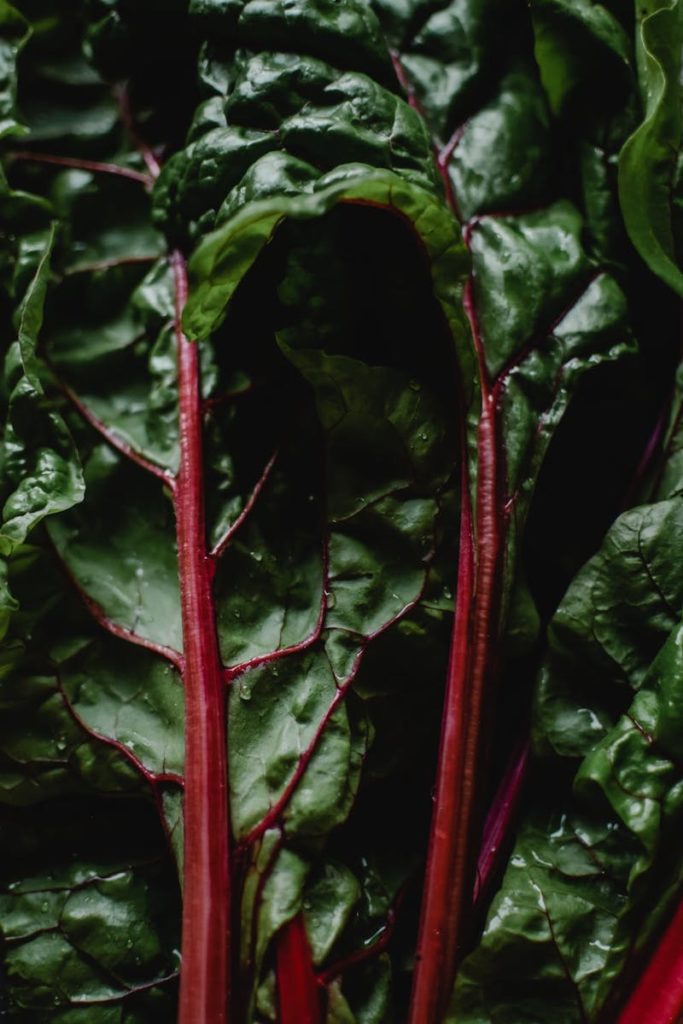
Along with warmer weather comes different produce hitting the shelves. The seasonal vegetable for this month is Swiss chard, which is in season during the spring, fall, and winter. This leafy green originated in Sicily and is very popular in Mediterranean cuisine. Swiss chard is a colorful, leafy green, with green, ribbed leaves and a stem that can vary between white, yellow, and red.
Swiss chard is versatile in that it can be harvested at both the young and mature stages. When Swiss chard is harvested in the younger stages, it is typically tender and when it is mature, the leaves are tougher. This leafy green is bitter when eaten raw, but this can be removed when cooked or paired with a salad dressing.
Nutritional Facts and Health Claims
Leafy greens are generally packed full of beneficial nutrients, Swiss chard, in particular, has Vitamins A & C, and potassium. It is known for regulating blood sugar level, lowering blood pressure, detoxing the body, and preventing heart disease. Swiss chard is also known to be helpful in the protection and structure of bones and brain strength. Some other health benefits include the prevention of different types of cancer, improvement of digestion, and boosting the immune system.
Storage:
Refrigerating Swiss chard:
— Do not wash until ready to use.
— Keep wrapped in a damp towel or place in a plastic bag and store in the hydrator/crisper drawer.
— Can be refrigerated 2-4 days.
Freezing Swiss chard:
— Put into boiling water for three minutes and then cool immediately in an ice bath.
— Drain the water, place into freezer bag, and remove excess air to prevent freezer burn. Store in freezer 8-12 months.
Use: Here are some great recipes to try out: Savory Greens or Pasta, Greens, Beans, and Chicken
Cooking note, if the stems are thick: separate stems from the leaves and cook the stems longer to achieve tenderness without overcooking the leaves (leaves will cook quickly!).

Calista Perez is an undergraduate, public health student at Baylor University. She is serving as an intern with Texas A&M AgriLife Extension service and has enjoyed working with Better Living for Texans to serve the community of McLennan County.
The Act Locally Waco blog publishes posts with a connection to these aspirations for Waco. If you are interested in writing for the Act Locally Waco Blog, please email Ferrell Foster at [email protected].
REFERENCES:
Savory Greens recipe from:
https://snap-ed.michiganfitness.org/wp-content/uploads/cooked-greens-family-newsletter-2016.pdf
Pasta, Greens, Beans, and Chicken recipe from:
https://snaped.fns.usda.gov/seasonal-produce-guide/swiss-chard
By Paula Solano
In February, we observe a host of meaningful observances — Black History Month, American Heart Month, National Children’s Dental Health Month, National Weddings Month, Valentine’s Day, and more.

The seasonal fruit for this month’s Better Living for Texans blog is the avocado. Avocados are in season in the spring, summer, and winter. Avocados are native to the tropics of Central America. The United States provides 6% of the world’s avocado crop, ranking third to Mexico and Chile. California is the largest producer of avocados in the United States. An avocado tree can produce up to 400 avocados annually.
Nutritional Facts and Health Claims
Avocados are cholesterol-free; high in vitamin B6; sodium-free; high in vitamin E; and a good source of potassium, magnesium, folate, and fiber. The Dietary Guidelines for Americans and the American Heart Association recommend consumption of nutrient-dense foods, limiting the number of saturated fats, trans fat, added sugars, and sodium consumed. Avocados are considered a good source of good fat (75 percent of the fat in an avocado is unsaturated).
Hypertension & Sodium:
Avocados are sodium-free. Diets low in sodium may reduce the risk of high blood pressure, a disease associated with many factors.
Shopping, Storage and How to Cut:
— Choose avocados that are firm — which give slightly when pressed. These are normally ready to eat.
— Store unripe avocados at room temperature. To ripen a firm avocado, place it in a paper bag with an apple.
— Cut avocados in half length-wise around the pit.
— Hit the pit with a sharp knife, twist to free pit and discard.
— Cube, slice, and scoop with a spoon or knife.
Get the Facts!
Wash your hands as recommended by the CDC, and clean contact surfaces often.
The U.S. Department of Agriculture MyPlate provides recipes, tips and resources to guide you in creating a healthy eating plan. Start simple, download the MyPlate App, an easy-to-use app that will help guide you and track your progress.
Use:
Avocados can be added to salads, soups, as guacamole, on sandwiches, applied as butter on toast, a substitute for sour cream. Avocado also makes a great puree to serve as baby food.
Here are two avocado recipes from EatFresh.org — Avocado Puree and Avocado Garden Salad. The first is for use as baby food; the second one is for those of us who are older.
Share your favorite recipe with us.
Enjoy!

Paula Solano is a Master in Public Health student at Baylor University, certified Community Health Worker, an intern at the Texas A&M AgriLife Extension Service. A Waco native, she is passionate about serving her community, particularly underserved and underrepresented citizens.
The Act Locally Waco blog publishes posts with a connection to these aspirations for Waco. If you are interested in writing for the Act Locally Waco Blog, please email Ferrell Foster at [email protected].
—
Due to the continued spread of COVID-19 and the challenges it poses to communities across Texas, Texas A&M AgriLife Extension and many others continue to practice public health recommendations. Whether we are communicating online or face-to-face know that program content will always be research-backed to help individuals navigate decisions for themselves and their families. For information on resources, ideas, and programs for yourself and family visit Texas A&M AgriLife’s HUB.
USDA is an equal opportunity provider and employer. This material was funded by USDA’s Supplemental Nutrition Assistance Program. To learn more about SNAP or to apply for benefits, visit www.yourtexasbenefits.com
References:
Centers for Disease Control and Prevention (2021) Your Guide to Masks. Retrieved from: https://www.cdc.gov/coronavirus/2019-ncov/prevent-getting-sick/about-face-coverings.html
Eat Fresh (2021) Avocado. Retrieved from: https://eatfresh.org/discover-foods/avocado
Fruits and Vegetables (2021) Avocado. Retrieved from: https://fruitsandveggies.org/fruits-and-veggies/avocado/
Harvest of the Month (2011) Exploring California Avocados Taste Testing. Retrieved from: https://harvestofthemonth.cdph.ca.gov/documents/Spring/Avocados/Avocado%20-%20Educator’s%20Newsletter_Final.pdf
Iowa Nutrition Network (2020) Avocado. Retrieved from: https://idph.iowa.gov/Portals/1/Files/INN/Avocaco.pdf
By Paula Solano
Cheers to the New Year! A new year, a new beginning. As we return to our routines, a little planning will not only save time and money, it can help you set and maintain a new routine.
Our environment and communities have a great influence on our beliefs and behaviors. As we begin to plan for the return of in-person learning, I’m reminded of a person who had a significant impact on the nutrition choices I was making as a parent. A brief conversation transformed my thoughts on packing school lunch. Now, packing lunch or even drinks and a snack are essential in our household.
The seasonal vegetable for this month’s “Better Living for Texans” blog is lettuce. Lettuce is in season in the spring and fall and has an ethnic presence in Asian, Southeast Asian (Vietnam, Cambodia, Laos), African, Latino, and Mediterranean cuisines.
Did you know May is National Salad Month? Share your photos on social media platforms using #RomaineLettuce! @fruitsandveggies. I’ve selected lettuce as the vegetable of the month as it represents a nutrition staple and can be paired with endless accompanying fruits, vegetables or serve as a side dish for a meal.
Nutritional Facts and Health Claims
While many factors impact one’s health, let’s learn nutritional claims about lettuce. The nutritional value of lettuce varies, generally, lettuce is low fat, saturated fat-free, cholesterol free, sodium free, high in vitamin A, low calorie, and a good source of folate (folic acid).
According to the American Cancer Society and American Cancer Institute, foods rich in vitamin A and C (antioxidants) protect against some forms of cancer.
Hypertension & Sodium: A diet low in sodium may reduce the risk of high
blood pressure, a disease associated with various factors. Lettuce contains very low sodium.
Coronary and Risk of Coronary Heart Disease & Dietary Saturated Fat: While many factors impact heart disease, a diet low in saturated fat and cholesterol may reduce the risk of the disease. Lettuce contains no saturated fat or cholesterol.
Cancer & Fiber – Containing Grain Products, Fruits, and Vegetables: Lettuce is high in vitamin A. A low-fat diet rich in fruits and vegetables may reduce the risk of some types of cancer. The disease is associated with various factors.
Shopping & Storage:
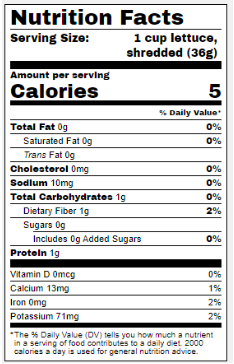
Lettuce is a cool weather crop. When shopping for lettuce,
select those closely bunched, with a fresh appearance.
Avoid those with brown or wilting edges.
Avoid storing lettuce with apples, pears, or bananas.
Wrap fresh, unwashed lettuce in plastic wrap and store for a few
days. Cooler temperature will maintain lettuce fresh longer.
Discard lettuce that appears to have brown spots or has a slimy
appearance.
Get the Facts!
Wash your hands as recommended by the CDC and clean contact
surfaces often.
The U.S. Department of Agriculture MyPlate provides recipes,
tips, and resources to guide you in creating a healthy eating plan.
Start simple, download the MyPlate App, an easy-to-use app that
will help guide you and track your progress.
Use:
Avocado Garden Salad
Source: Eat Fresh
Cook Time: 20 minutes
Serving: 6
Ingredients
- 6 cups of mixed salad greens
- 3 tomatoes (medium) chopped
- 5 green onions chopped
- 1 cucumber small, peeled and chopped
- 2 tablespoon of lemon juice
- 1/3 teaspoon garlic powder
- ½ teaspoon black pepper (ground)
- ½ teaspoon salt
- 1 avocado (large) peeled
Directions
- In a large serving bowl, mix salad greens, tomatoes, onions, and cucumbers
- In a small bowl, mix lemon juice, garlic powder, ground black pepper, and salt. Stir with a fork or whisk. Pour over the salad mixture and toss together.
- Cut the avocado half lengthwise, remove the pit, and peel avocado halves. Slice into thin wedges.
- Arrange avocado slices on top of the salad and serve.
Nutrition Information and More
Serving size: 1½ cup
Total calories 78, total fat 5g, saturated fat 1g, carbohydrates 9g, protein 2g, fiber 4g, and sodium 222 mg
Recipe: https://eatfresh.org/recipe/salads/avocado-garden-salad#.X_UHl9hKiUk
Tasty Taco Rice Salad
Source: Arizona Health Zone
Servings: 8
Ingredients
- 1 pound of lean ground beef
- 1 ½ cup of instant brown rice, cooked
- 2 cups of water
- 1 cup of onion, chopped
- 1 tablespoon of chili powder
- 3 cups of tomatoes chopped
- 1 seeded jalapeño finely chopped
- 2 cups of spinach or romaine lettuce
- 1 ½ cup of low-fat cheese, shredded
Directions
- Washing hands with soap and warm water.
- Wash onion, tomatoes, jalapeño, and spinach or romaine lettuce before preparing.
- Cook ground meat in a large skillet until brown (160℉). Drain off fat. Rinse meat with warm water to remove the grease.*
- Add rice, water onion, and chili powder to meat in skillet.
- Cover. Simmer over low heat about 15 minutes to cook rice.
- Add tomatoes and jalapeño. Heat for 2-3 minutes.
- Layer spinach or romaine lettuce, rice mixture and cheese on a plate.
- Serve.
*Do not pour grease down the drain. Allow grease to harden, then place in the trash.
Recipe: https://www.azhealthzone.org/recipes/tasty-taco-rice-salad
Nutrition Facts (Per Serving)
Serving size 1 ½ cups
Calories 191, carbohydrate 19g, protein 18.8g, total fat 4.5g, saturated fat 2g, trans fat 0g, cholesterol 35 mg, fiber 2g, total sugars 3g, sodium, 260mg, calcium 110mg, folate 30 mcg, iron, 1.75 mg, calories from fat 22%.
Share your favorite recipe with us!
Enjoy!

Paula Solano is a Master in Public Health student at Baylor University, certified Community Health Worker, an intern at the Texas A&M AgriLife Extension Service. A Waco native, she is passionate about serving her community, particularly underserved and underrepresented citizens.
The Act Locally Waco blog publishes posts with a connection to these aspirations for Waco. If you are interested in writing for the Act Locally Waco Blog, please email Ferrell Foster at [email protected].
—
Due to the continued spread of COVID-19 and the challenges it poses to communities across Texas, Texas A&M AgriLife Extension and many others continue to practice public health recommendations. Whether we are communicating online or face-to-face know that program content will always be research-backed to help individuals navigate decisions for themselves and their families. For information on resources, ideas, and programs for yourself and family visit Texas A&M AgriLife’s HUB.
USDA is an equal opportunity provider and employer. This material was funded by USDA’s Supplemental Nutrition Assistance Program. To learn more about SNAP or to apply for benefits, visit www.yourtexasbenefits.com
References:
Arizona Health Zone (2021) Tasty Taco Rice Salad. Retrieved from: https://www.azhealthzone.org/recipes/tasty-taco-rice-salad
Eat Fresh (2021) Avocado Garden Salad. Retrieved from: https://eatfresh.org/recipe/salads/avocado-garden-salad#.X_UHl9hKiUk
Fruits and Veggies (2021) Leaf Lettuce. Retrieved from: https://fruitsandveggies.org/fruits-and-veggies/leaf-lettuce/
University of Illinois Extension (2021) Watch Your Garden Grow. Retrieved from: https://web.extension.illinois.edu/veggies/lettuce.cfm
By Paula Solano
As the year 2020 comes to an end, many of us begin to think about New Year’s resolutions. Resolutions are often associated with nutrition, physical activity, spending more or less time doing something. Changing habits or behaviors can be challenging, but not impossible.
What are some of your New Year’s resolutions? Feel free to share! Honestly, I cannot recall the last time I made a New Year’s resolution. Most of my resolutions become lifestyle changes, changes I adopt throughout the year.
One of my resolutions or lifestyle changes was self-care. Through this change, I make time to decompress, rest, and reflect. Then, I proceed with all my responsibilities, many of which revolve around my home, work, and school.
As I reflect on the past year and all the pieces that encompass my daily life, something that has changed in my household is preparing meals as a family and having meals at home. I’ve learned that a little effort and planning will save unnecessary trips to the grocery store, or we just have to get creative.
Similarly, I’ve observed how my daughters look forward to helping, and I hope their enthusiasm will continue. Our plan for the holiday festivities — keep it small, keeping those who have lost a loved one, their employment, or are struggling near and dear in our prayers.
During my time with the Family and Community Health unit of Texas A&M AgriLife Extension Service in McLennan County, I’ve gained increased understanding related to various programs offered by FCH and have applied much into my daily life — nutrition education, food safety, and selecting and storage of fresh fruits and vegetables. I’ve learned that eating healthy doesn’t have to be boring or expensive.
The seasonal vegetable for this month’s Better Living for Texans blog post is the sweet potato. Sweet potatoes have a presence in Asian, Cuban, Puerto Rican, Latino, Mediterranean, Pacific Island, and Southern foods. Add a twist to your meals with a yummy sweet potato, enjoy them grilled, in a salad, as a snack, or mashed.
Nutritional Facts and Health Claims
While many factors impact one’s health, let’s take a look at sweet potato health benefits. Did you know sweet potatoes are low in sodium, cholesterol free, fat free, saturated fat free, and a good source of fiber? Sweet potatoes are also high in vitamins A and C.
Hypertension & Sodium: Since sweet potatoes are low in sodium, they can reduce the risk of high blood pressure when part of a low-sodium diet.
Coronary Heart Disease & Dietary Saturated Fat: A diet low in cholesterol and saturated fat can reduce the risk of coronary disease.
Cancer & Fiber Containing Grain Products, Fruits, and Vegetables: A low-fat diet containing fiber in grain products, fruits, and vegetables may reduce risk of some types of cancer.
High Blood Pressure/Stroke & Potassium: A diet containing a good source of
potassium could reduce the risk of blood pressure and stroke.
Shopping & Storage:
When shopping for fresh sweet potatoes, select those that are firm,
with smooth skin. Avoid those that have cracks, soft spots, or blemishes.
Sweet potatoes are also conveniently available frozen and in a can.
Store sweet potatoes in a cool, dark space for use within 3-5 weeks.
Get the Facts:
Wash your hands as recommended by the CDC, and clean contact surfaces often. The U.S. Department of Agriculture MyPlate provides recipes, tips, and resources to guide you in creating a healthy eating plan.
Start simple, download the MyPlate App, an easy-to-use app that will help guide you and track your progress.
Lentil Minestrone (source: MyPlate Recipe)
Cook Time: 80 minutes
Serving: 6
Ingredients
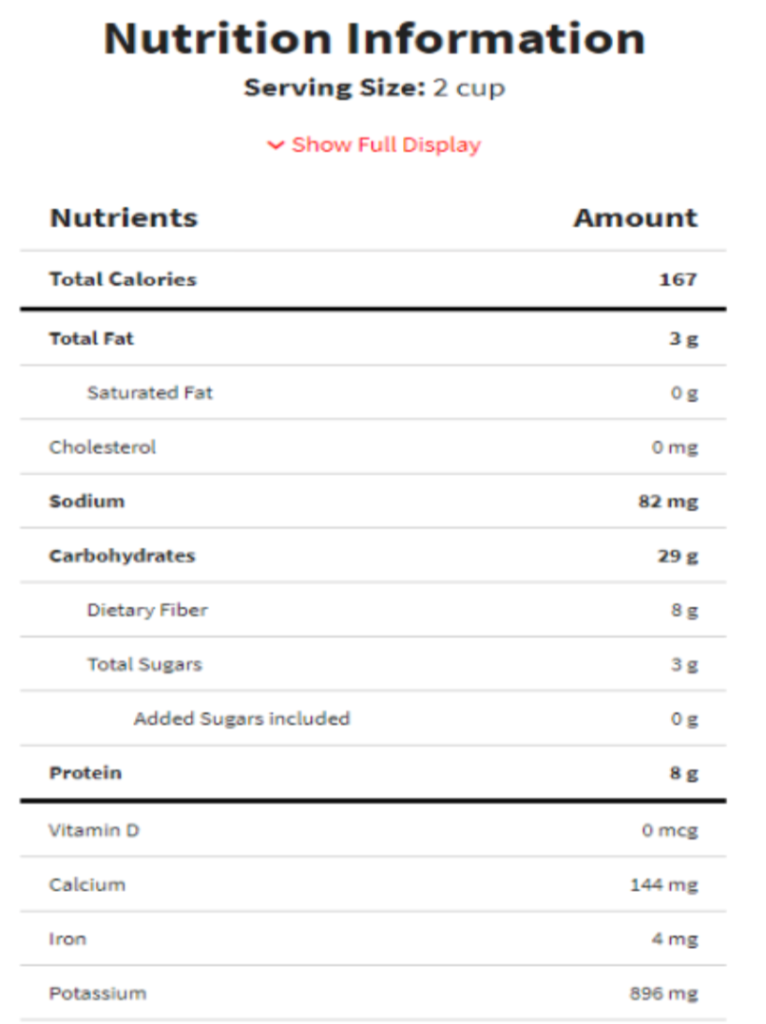
- 1 tablespoon olive or vegetable oil
- 1 yellow onion (peeled and chopped)
- 2 cloves garlic (peeled and minced)
- 3 carrots (scrubbed and diced into 1/4-inch pieces)
- 1 celery stalk (diced into 1/4-inch pieces)
- 1 sweet potato (scrubbed and diced into 1/4-inch pieces)
- 1 zucchini (diced into 1/4-inch pieces or 1 cup of frozen zucchini)
- 2 cups canned low-sodium, diced tomatoes (including liquid or fresh tomatoes)
- 1/2 cup lentils (brown or red)
- 8 cups water
- 1 cube low-sodium chicken bouillon
- 4 cups kale (washed and chopped into 1/4-1/2-inch pieces)
Directions
- Put a soup pot on the stove over medium-high heat. When the pot is hot, add the oil. Add onion and garlic and cook about 7 minutes until golden.
- Add carrots, celery, sweet potato, and zucchini and cook about 10 minutes until slightly tender.
- Add tomatoes, lentils, water, and chicken bouillon cube and bring to a boil over high heat. Turn the heat down to low, cover and cook 40 minutes.
- Add the kale and cook an additional 20 minutes. Serve right away or cover and refrigerate for up to 3 days.
Mock Southern Sweet Potato Pie (source: Choose MyPlate)
Prep Time: Approximately 1.5 hours
Servings: 16 portions
Bake Time: 60 minutes
Ingredients
Crust:
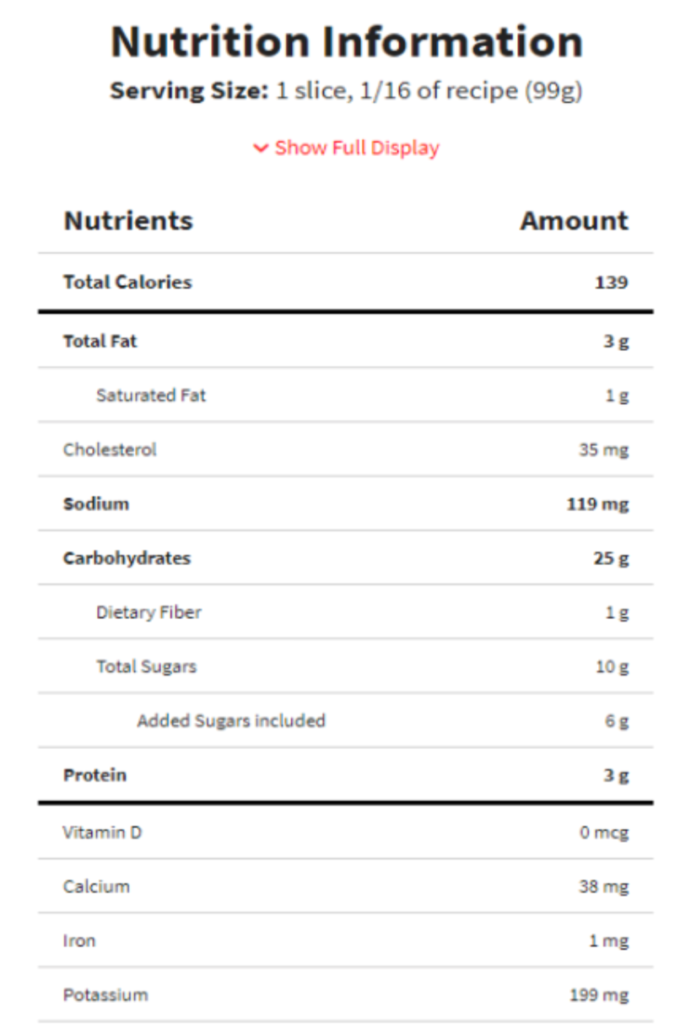
- 1 1/4 cups flour (all purpose)
- 1/4 teaspoon sugar
- 1/3 cup milk, non-fat
- 2 tablespoons vegetable oil
Filling:
- 1/4 cup sugar (white)
- 1/4 cup brown sugar, packed
- 1/2 teaspoon salt
- 1/4 teaspoon nutmeg
- 3 egg (large, beaten)
- 1/4 cup evaporated milk, non-fat (canned)
- 1 teaspoon vanilla extract
- 3 cups sweet potatoes, cooked, skin removed and mashed
Directions
Preheat oven to 350 degrees.
Crust:
- Combine the flour and sugar in a bowl.
- Add milk and oil to the flour mixture.
- Stir with fork until well mixed and then form pastry into a smooth ball with your hands.
- Roll the ball between two 12-inch squares of waxed paper using short, brisk, strokes until pastry reaches edge of paper.
- Peel off top paper and invert crust into pie plate.
Filling:
- Combine sugars, salt, spices and eggs.
- Add milk and vanilla. Stir.
- Add sweet potatoes and mix well.
- Pour mixture into pie shell.
- Bake for 60 minutes or until crust is golden brown.
- Cool and cut into 16 slices.
- Source:
National Heart, Lung and Blood Institute (NHLBI), Heart Healthy Home Cooking African American Style, p.24-25
Share your favorite sweet potato recipes with us.
Enjoy!
Paula Solano is a Master in Public Health student at Baylor University, certified Community Health Worker, and volunteering at the Texas A&M AgriLife Extension Service. A Waco native, Solano is passionate about serving her community, particularly underserved and underrepresented citizens.

The Act Locally Waco blog publishes posts with a connection to these aspirations for Waco. If you are interested in writing for the Act Locally Waco Blog, please email [email protected] for more information.
Due to the continued spread of COVID-19 and the challenges it poses to communities across Texas, Texas A&M AgriLife Extension and many others continue to practice public health recommendations. Whether we are communicating online or face-to-face know that program content will always be research-backed to help individuals navigate decisions for themselves and their families. For information on resources, ideas, and programs for yourself and family visit Texas A&M AgriLife’s HUB.
USDA is an equal opportunity provider and employer. This material was funded by USDA’s Supplemental Nutrition Assistance Program — SNAP. To learn more about the Supplemental Nutrition Assistance Program (SNAP) or to apply for benefits, visit www.yourtexasbenefits.com
References:
Fruits & Veggies (2020) Sweet Potato. Retrieved from: https://fruitsandveggies.org/fruits-and-veggies/sweet-potato/
Fruits and Veggies (2020) Top 10 Ways to Enjoy Sweet Potatoes. Retrieved from: https://fruitsandveggies.org/stories/top-10-ways-to-enjoy-sweet-potatoes/
By Paula Solano
Thanksgiving and fall festivities might look a bit different for most of us this year. When I think about the holidays, I think about food, fellowship, reflecting on the past year, and forward-thinking on years to follow.
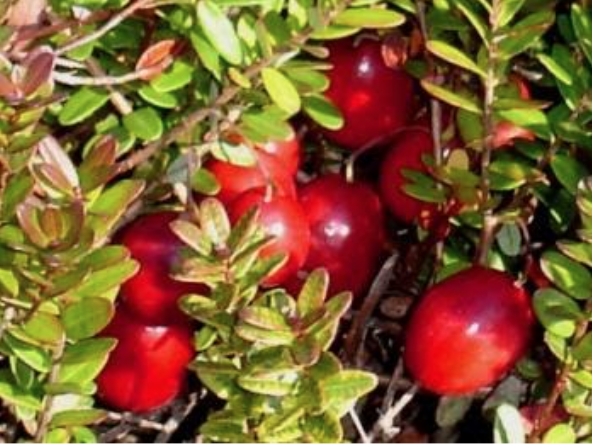
Food is in the center of many cultures, in the center celebrations, those of joy and those of mourning. The types of foods we consume during the holidays also look different in many cultures.
Tamales are a Thanksgiving staple in our gatherings, along with our turkey, ham, and desserts. Nevertheless, this year we have the opportunity to make changes for health, wellness, and safety.
I look forward to this year’s holidays as a time to recharge and reflect. Our Thanksgiving celebration will be different as we will continue to practice social distancing, particularly thinking about our older adult loved ones and medically fragile friends. It is also a time of solidarity for those who have unexpectedly lost someone due to COVID-19.
This year, we will opt out of the large gatherings or travel and stay home. Nutrition and physical activity have gained substantial importance in our household and we hope to continue these practices as we prepare our Thanksgiving meal on a much smaller scale.
I’ve invested some time reviewing options to introduce to my picky eaters (my three children). I have had some successes and learned many lessons along the way. Particularly thinking about the cookie recipe I’ve included in this blog, a lesson learned from preparing the recipe is that I might have succeeded in sneaking cranberries had I pureed the cranberries. Needless to say, I considered this recipe a success when two-thirds of my kiddos gave the cookies a thumbs up.
Changing habits and behaviors can bring forth challenges; however, consistency is key. Health and wellness are at the forefront for many, and I personally hope our healthier choices will continue beyond this pandemic. Scaling back will be less complex as we face the possibility of preparing a smaller “feast.” Feeding a family of five will call for a smaller spread yet equally as cherished.
Our spread will likely includes cranberries. They are a seasonal fruit and can be found in the produce section, frozen, in a can, or as 100% juice.
Nutritional Facts and Health Claims
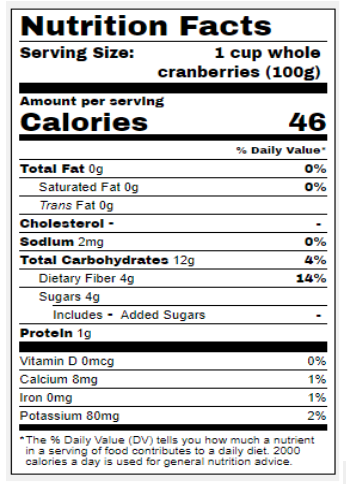
Did you know cranberries are a good source of antioxidants? One cup of whole cranberries contains 46 calories, calcium, iron, and potassium. Additionally, they’re sodium, cholesterol, and saturated fat free.
Cranberries offer unique health benefits, including potentially reducing the risk of high blood pressure when part of a low-sodium diet. Drinking cranberry juice can reduce the risk of UTIs.
Shopping & Storage
When shopping for fresh cranberries, select those that are firm to the touch. A single fresh cranberry will bounce if dropped on the floor. Avoid selecting cranberries that are soft or contain spots. Fresh cranberries may be refrigerated for up to two months, then, it is recommended that you freeze them.
Get the Facts!
Wash your hands as recommended by the CDC and clean contact surfaces often.
The U.S. Department of Agriculture MyPlate provides recipes, tips, and resources to guide you in creating a healthy eating plan. Start simple, download the MyPlate App, an easy-to-use app that will help guide you and track your progress.
Use:
OATMEAL CHOCOLATE CHUNK COOKIES

Prep Time: 10 minutes
Serving: 2.5 dozen cookies
Cook Time: 12 minutes
Ingredients
2/3 cup of butter or margarine, softened
2/3 cups of brown sugar
2 large eggs
1 1/2 cups of old-fashioned oats
1 1/2 cups of flour
1 teaspoon of baking soda
1/2 teaspoon of salt
1 6-once Ocean Spray ®Craisins Original Dried Cranberries
2/3 cup of white or semi-sweet chocolate chunk cookies
Directions
Preheat oven to 375F degrees.
Beat butter/margarine and sugar together in a medium mixing bowl until light and fluffy. Add eggs and mix well.
In a separate bowl, combine oats, flour, baking soda, and salt. Add to butter mixture in several additions, mix well after each addition. Stir dried cranberries and chocolate chunks.
Drop round teaspoonfuls onto an ungreased cookie sheet. Bake for 10-12 minutes or until golden brown. Cool on a wire rack.
Per serving: Cal. 130, Fat 6g (9%DV), Sat. Fat. 3.5g (18%DV), Sod. 90mg (4%DV), Carb. 18g (6% DV), Sugar 11g, Pro. 2g
CRANBERRY NUT BREAD
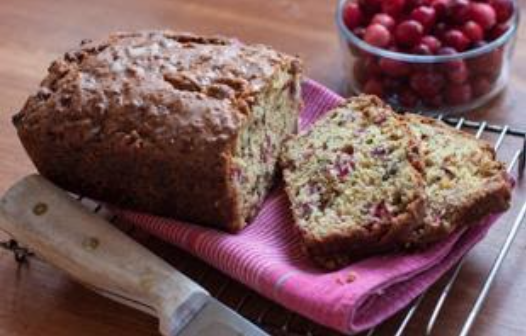
Prep Time: Approximately 1.5 hours
Servings: 15 portions
Cook Time: 50-60 minutes
Ingredients
2 cups of flour
2/3 cup sugar
1 1/2 teaspoon baking powder
1 1/2 teaspoon of baking soda
2 teaspoon grated orange peel
3/4 cup orange juice
4 tablespoon butter or margarine melted
1 egg or 2 egg whites (medium)
1 cup of chopped cranberries (I used a can)
1/3 cup chopped walnuts
1/3 powdered sugar (1/3 cup, optional, for glaze)
1 teaspoon of water (optional for glaze)
Directions
Preheat oven at 350F degrees. Mix flour, sugar, baking powder, and baking soda in a large bowl.
Grate orange peel, then squeeze juice from the orange. Add additional juice if needed to make 3/4 cup.
Blend orange juice, butter, egg, and grated orange peel in a separate bowl. Then add the flour mixture, stirring until blended, and add the cranberries and walnuts.
Pour batter into a 9-by-5-inch loaf pan, greased at the bottom.
Bake for 50-60 minutes or until a toothpick inserted in the center comes out clean. Cool in pan for 10 minutes.
Remove and cool completely in a wire rack.
Optional: To make the glaze, mix powdered sugar and water. Add water slowly to create a thin glaze, then drizzle over the cooled loaf.
Enjoy!

Paula Solano is a Master in Public Health student at Baylor University, certified Community Health Worker, volunteering at the Texas A&M AgriLife Extension Service. A Waco native, she is passionate about serving her community particularly underserved and underrepresented citizens.
Due to the continued spread of COVID-19 and the challenges it poses to communities across Texas, Texas A&M AgriLife Extension and many others continue to practice public health recommendations. Whether we are communicating online or face-to-face know that program content will always be research-backed to help individuals navigate decisions for themselves and their families. For information on resources, ideas, and programs for yourself and family visit Texas A&M AgriLife’s HUB. USDA is an equal opportunity provider and employer. This material was funded by USDA’s Supplemental Nutrition Assistance Program — SNAP. To learn more about the Supplemental Nutrition Assistance Program (SNAP) or to apply for benefits, visit YourTexasBenefits.com.
The Act Locally Waco blog publishes posts with a connection to these aspirations for Waco. If you are interested in writing for the Act Locally Waco Blog, please email [email protected] for more information.
By Lindsey Breunig-Rodriguez
Every year we like to provide program updates and share new curriculum. Do not worry, next month we will back to regular scheduled fruit and veggie facts.
Greetings from the McLennan County Texas A&M AgriLife Extension Service! My name is Lindsey, and I am the Extension agent for the Better Living for Texans (BLT) Program. BLT is a nutrition education program for adults and youth who are SNAP participants or SNAP eligible, and in October we kicked off our 26th year of serving Texans.
Programs are free and rooted in research. Evidence-based information empower individuals, families, and communities to make positive changes for healthier lives. Whether we meet in-person, online, virtually, or through a combination of methods, we are here to serve you. This monthly update will feature our available curriculum. You will see that BLT is for all Texans.
Curriculum Highlights:
FOCUS: NUTRITION
A Fresh Start to a Healthier You! – Target Audience: Adults
Promotes increasing fruit and vegetable intake, food safety, and food resource management.
A Fresh Start to a Healthier You! – ONLINE – Target Audience: Adults
Promotes increasing fruit and vegetable intake, food safety, and food resource management.
Conducted completely online.
Get the Facts – Target Audience: Adults
Teaches how to read Nutrition Facts Labels and identify portion sizes, sodium, fat, and added sugar found in foods.
Healthier Carbohydrates -Target Audience: Adults
Promotes a healthful eating pattern to prevent or delay diet related chronic diseases
Be Well, Live Well – Target Audience: Older Adults
Promotes nutrition and physical activity specifically targeting older adults
Color Me Healthy – Target Audience: Preschoolers and Kindergarteners
Provides fun, innovative, interactive learning opportunities on physical activity and healthy eating.
Balancing Food & Play – Target Audience: 3rd-5th graders
Promotes good nutrition and healthy weight; physical activity; limiting screen time; increase fruit and vegetable intake; drinking milk with meals and water with snacks.
Choose Healthy – Target Audience: Middle Schoolers
Teaches about MyPlate, physical activity (energy balance), making healthy food choices, and choosing healthy drinks.
FOCUS: GARDENING
Growing and Nourishing Healthy Communities – Target Audience: Adults
Teaches how to build gardens and grow fresh vegetables.
Learn, Grow, Eat and GO! – Target Audience: 3rd-5th graders
Enhances gardening skills and increased fruit and vegetable intake
FOCUS: PHYSICAL ACTIVITY
Walk Across Texas! (WAT!) – Target Audience: all ages
Promotes increased physical activity through tracking miles walked
Walk N Talk – Target Audience: all ages
Promotes increased physical activity – WAT! with added nutrition messages in a discussion format. Discussion topics are: 1. Fruits and Vegetables, 2. Rethink Your Drink! (hydration, flavored waters, sugary drinks, etc.)
If you have questions, want to plan and brainstorm, or want to hear more, please reach out to Lindsey at McLennan County’s Texas A&M AgriLife Extension office:
Phone, 254-757-5180 or email, [email protected]
Due to the continued spread of COVID-19 and the challenges it poses to communities across Texas, Texas A&M AgriLife Extension and many others continue to practice public health recommendations. Whether we are communicating online or face-to-face know that program content will always be research-backed to help individuals navigate decisions for themselves and their families. For information on resources, ideas, and programs for yourself and family visit Texas A&M AgriLife’s HUB.
USDA is an equal opportunity provider and employer. This material was funded by USDA’s Supplemental Nutrition Assistance Program — SNAP. To learn more about the Supplemental Nutrition Assistance Program (SNAP) or to apply for benefits, visit www.yourtexasbenefits.com

Lindsey Breunig-Rodriguez is an Extension Agent for the Better Living for Texans program with the Texas A&M AgriLife Extension Service. She is originally from Grapevine but now calls Waco home. A graduate from Baylor University, she loves to venture out to Cameron Park, visit the local Farmers Market, and try out the awesome eateries in Waco. If you see her and hear a loud bark, that’s her pup Lucy Ann just saying hello.
The Act Locally Waco blog publishes posts with a connection to these aspirations for Waco. If you are interested in writing for the Act Locally Waco Blog, please email [email protected] for more information.
Happy fall, y’all! I hope everyone is enjoying the cooler weather as much as I am.
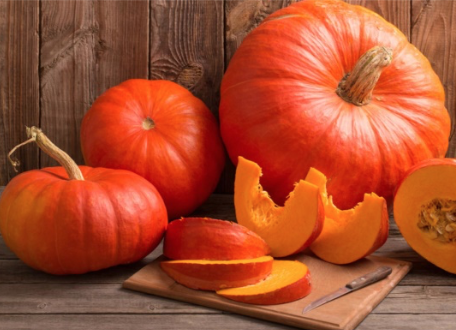
The fruit I will feature in this blog is often mistaken as a vegetable, an all-time favorite the pumpkin. Pumpkins bring forth a bit of nostalgia, thinking of my late grandmother who would give us sun-toasted pumpkin seeds. I enjoy observing the anticipation and excitement of all things pumpkin spice.
Did you know eighty percent of our United States pumpkin supply is available in October? Let’s not forget our pumpkin patches, fall décor, children’s activities, and oversized sweaters. I look forward to all the new and creative ways individuals and communities will embrace the season while practicing social distancing.
Select pumpkins that are firm and heavy. Look for those with a one to two-inch stem, those with small stems will decay faster. Avoid those with soft spots or blemishes. Pumpkins may last up to two months when stored in a cool, dark, and dry location.
Canned pumpkin is also an option. Pumpkins can also be purchased canned and are safe to consume past the expiration date so long as the can is free of dents, swelling, or rust. For decorative purposes, keep in mind lopsided pumpkins are not necessarily bad.
Pumpkins are 90% water. They’re low in calories, fat free, cholesterol free, saturated fat free, sodium free, high in vitamin A, and a great source of vitamin K.
Get the Facts!
Wash your hands as recommended by the CDC, and clean contact surfaces often.
The U.S. Department of Agriculture MyPlate provides recipes, tips, and resources to guide you in creating a healthy eating plan. Start simple, download the MyPlate App, an easy-to-use app that will help guide you and track your progress.
Enjoy the tasty recipes below:
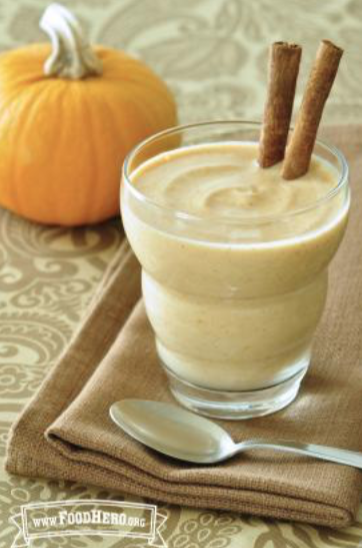
Pumpkin Smoothie in a Cup
Prep Time: 5 minutes
Serving: 1 cup
Ingredients:
2/3 cups low-fat vanilla yogurt or 1 six ounce container
¼ cup canned pumpkin
2 teaspoons brown sugar
¼ teaspoon cinnamon
1/8 tea spoon nutmeg (optional)
Instructions:
Combine ingredients in a bowl or blender
Mix until smooth
Serve or refrigerate within 2 hours
Enjoy!
Additional suggestions:
Add granola
Excess canned pumpkin can be frozen
Low-Fat Pumpkin Bread
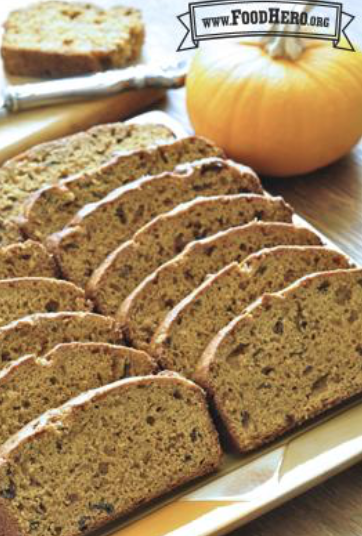
Prep Time: 15 minutes
Cooking Time: 1 Hour
Serving: 20 Slices
Ingredients:
1 ½ cup of whole wheat flour
1 1/3 cup all-purpose flour
2 teaspoons baking powder
1 teaspoon of baking soda
½ teaspoon salt
1 teaspoon of cinnamon
½ teaspoon of grown cloves
¼ teaspoon of ground ginger
¼ teaspoon nutmeg
4 eggs
1 cup canned pumpkin
1 cup applesauce
¾ cup packed brown sugar
¾ cup sugar
Directions:
Preheat the oven 350 degrees
Lightly coat an 8 ½ x 4 ½ inch loaf pan with cooking spray oil and set aside
Combine flours, baking powder, baking soda, cinnamon, salt, cloves, ginger and nutmeg in a medium bowl (dry ingredients)
Combine eggs, pumpkin, applesauce, brown sugar and sugar in a separate bowl and mix (wet ingredients)
Combine wet and dry ingredients. Careful not to over mix
Pour batter onto pan and spread into the corners
Bake for approximately 60 minutes or until a wooden pick comes out clean when inserted in the middle
Remove from oven and cool for 10 minutes
Remove loaf from pan and slice
Wrap and freeze leftovers for up to one month
Enjoy!

Paula Solano is a Master in Public Health student at Baylor University, a certified Community Health Worker, and is volunteering at the Texas A&M AgriLife Extension Service. A Waco native, she is passionate about serving her community, particularly the underserved and underrepresented.
Due to the continued spread of COVID-19 and the challenges it poses to communities across Texas, Texas A&M AgriLife Extension and many others continue to practice public health recommendations. Whether we are communicating online or face-to-face know that program content will always be research-backed to help individuals navigate decisions for themselves and their families. For information on resources, ideas, and programs for yourself and family visit Texas A&M AgriLife’s HUB.
USDA is an equal opportunity provider and employer. This material was funded by USDA’s Supplemental Nutrition Assistance Program — SNAP. To learn more about the Supplemental Nutrition Assistance Program (SNAP) or to apply for benefits, visit www.yourtexasbenefits.com
References:
Food Hero (2020) Recipes. Retrieved from: https://foodhero.org/recipes/pumpkin-smoothie-cup
Texas A&M AgriLife Extension (2020) Vegetable Fact Sheet Guide. Retrieved from: https://mail.google.com/mail/u/0/?tab=wm#search/lindsey/FMfcgxwJXLmlTmrsWggKBbBkJgmzwHJC?projector=1&messagePartId=0.5
U.S. Department of Agriculture (2020) Pumpkins. Retrieved from: https://snaped.fns.usda.gov/seasonal-produce-guide/pumpkin
University of Illinois Extension (2020) Pumpkins and More. Retrieved from: https://web.extension.illinois.edu/pumpkins/selection.cfm

